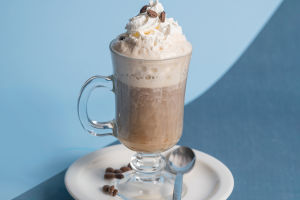Cold Brew And Milk
Cold brew iced lattes have surged in popularity, especially during warmer months. This refreshing drink, which originated from the idea of cold brewing, offers a smooth and rich coffee experience without the bitterness you often find in traditional iced coffee.
Cold brew coffee is made by steeping coffee grounds in cold water for an extended period, a method that became popular in the U.S. thanks to cafes and coffee chains. Now, more people are enjoying cold brew lattes at home, as they’re easy to make and customize.
Step-By-Step Recipe
1. Prepare the Cold Brew Coffee: Start by adding coarsely ground coffee to a jar or French press. Pour cold water over the grounds in a 1:4 ratio (1 cup of coffee to 4 cups of water). Stir gently and let the mixture sit in the fridge for 12-24 hours.
2. Strain the Coffee: After steeping, strain the coffee using a fine mesh sieve or coffee filter.
3. Milk and Sweetener: Add your preferred milk (whole, oat, almond, etc.) and any sweeteners to taste. For a latte, use equal parts cold brew and milk.
4. Ice and Mix: Fill a glass with ice, pour in the cold brew, and top it off with milk.
5. Optional Flavors: Add flavors like vanilla, caramel, or cinnamon for extra flair.
Best Milk Alternatives
If you’re looking for dairy-free options, there are plenty of great milk alternatives to choose from:
- Oat Milk: Creamy and naturally sweet, it’s perfect for adding richness to your latte without overpowering the coffee.
- Almond Milk: Lower in calories and with a nutty flavor, almond milk is a great light option, though it may not froth as well.
- Soy Milk: A versatile option with a thicker consistency, soy milk offers a similar richness to whole milk and works well for lattes.
- Coconut Milk: If you want a tropical twist, coconut milk’s slight sweetness and subtle coconut flavor can add depth to your cold brew.
What Coffee To Use
Choosing the right coffee is essential for making a great cold brew ice latte. Opt for coarsely ground coffee, as finer grounds may result in a bitter or over-extracted brew. Medium to dark roast coffees are often recommended for cold brew because they provide a bolder, richer flavor that pairs well with milk. Light roast coffee, on the other hand, may result in a more acidic taste, which may not blend as smoothly with milk.
Calories And Nutrients
A typical cold brew ice latte with whole milk (about 8 oz of coffee and 8 oz of milk) contains approximately 100-150 calories, depending on the milk type. Whole milk provides 8 grams of protein and 8 grams of fat. If you opt for a plant-based milk like almond or oat, the calorie content may be lower, but it will vary depending on the brand and added sugars. Cold brew itself has no calories, so the overall nutritional profile comes mainly from the milk and any sweeteners you add.
There are endless ways to personalize your cold brew ice latte. You can experiment with different types of milk or try adding flavors like chocolate syrup, vanilla, or even a hint of coconut milk. If you're feeling adventurous, try a seasonal twist by adding pumpkin spice or hazelnut syrup for a cozy autumn drink.


